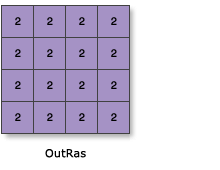Available with Spatial Analyst license.
Summary
Creates a raster of a constant value within the extent and cell size of the analysis window.
Illustration

Usage
The Create Constant Raster tool assigns the specified value to every cell in the output raster.
The constant value must be a numeric value. Scientific notation is acceptable (for example, 3.048e-4 for 0.003048).
Some typical reasons for creating a raster of all the same values include the following:
- A Mask environment has been set and you want a raster identifying all unmasked cells to use in a variety of other tools (for example, as a condition raster in the Con tool).
- You want all the values in an output raster from a mask or some selection process to be classified as a single value.
- You want to apply a constant value in an analysis to all cell locations in another raster—for example, you want to add five decibels to each location in a noise pollution raster.
See Analysis environments and Spatial Analyst for additional details on the geoprocessing environments that apply to this tool.
Syntax
CreateConstantRaster (constant_value, {data_type}, {cell_size}, {extent})| Parameter | Explanation | Data Type |
constant_value | The constant value with which to populate all the cells in the output raster. | Double |
data_type (Optional) | Data type of the output raster dataset.
If the specified data type is FLOAT, the values of the cells in the output raster will only be accurate to the constant value of 7 decimal places, regardless of the output format. | String |
cell_size (Optional) | The cell size for the output raster dataset. This is the value in the environment if specifically set. If not specifically set, it is the shorter of the width or height of the environment extent in the output spatial reference, divided by 250. | Analysis Cell Size |
extent (Optional) | The extent for the output raster dataset. The Extent is a Python class. In this tool, it is in the form of Extent(XMin, YMin, XMax, YMax)
The coordinates are specified in the same map units as the Output coordinate system environment setting. The extent will be the value in the environment if specifically set. If not specifically set, the default is 0, 0, 250, 250. | Extent |
Return Value
| Name | Explanation | Data Type |
| out_raster | The output raster for which each cell will have the specified constant value. | Raster |
Code sample
CreateConstantRaster example 1 (Python window)
This sample creates a float raster of a particular value at the defined cell size and extent.
import arcpy
from arcpy import env
from arcpy.sa import *
env.workspace = "C:/sapyexamples/data"
outConstRaster = CreateConstantRaster(12.7, "FLOAT", 2, Extent(0, 0, 250, 250))
outConstRaster.save("C:/sapyexamples/output/outconst2")
CreateConstantRaster example 2 (stand-alone script)
This sample creates an integer raster of a particular value at the defined cell size and extent.
# Name: CreateConstantRaster_Ex_02.py
# Description: Creates a raster from a constant value
# Requirements: Spatial Analyst Extension
# Import system modules
import arcpy
from arcpy.sa import *
# Set local variables
constantValue = 12
cellSize = 2
outExtent = Extent(0, 0, 250, 250)
# Check out the ArcGIS Spatial Analyst extension license
arcpy.CheckOutExtension("Spatial")
# Execute CreateConstantRaster
outConstRaster = CreateConstantRaster(constantValue, "FLOAT", cellSize,
outExtent)
# Save the output
outConstRaster.save("C:/sapyexamples/output/outconst")
Environments
Licensing information
- ArcGIS Desktop Basic: Requires Spatial Analyst
- ArcGIS Desktop Standard: Requires Spatial Analyst
- ArcGIS Desktop Advanced: Requires Spatial Analyst